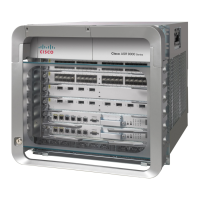115
Cisco ASR 9000 Series Aggregation Services Router Getting Started Guide
OL-28417-02
Introduction to the Cisco ASR 9000 Series Aggregation Services Router
Cisco ASR 9000 Series Router Overview
–
VPN to cross more than one service provider backbone.
–
VPN to exist in different areas.
–
confederations to optimize Internal Border Gateway Protocol (iBGP) meshing.
Cisco ASR 9000 Series Aggregation Services Router L2VPN and Ethernet Services Configuration Guide.QoS
The router supports many types of quality of service (QoS), which offers the following:
• QoS—Comprehensive QoS support with up to 3 million queues, Class-Based Weighted Fair
Queuing (CBWFQ) based on a three-parameter scheduler, Weighted Random Early Detection
(WRED), two-level strict priority scheduling with priority propagation, and 2-rate, 3-color (2R3C)
Policing are all supported.
• Cisco IOS XR Software—This software supports a rich variety of QoS mechanisms, including
policing, marking, queuing, dropping, and shaping. In addition, the operating systems support
Modular QoS CLI (MQC). Modular CLI is used to configure various QoS features on various Cisco
platforms.
• H-QoS—Is supported on both the SIP based interfaces and the Ethernet interfaces. For EVCs
four-level H-QoS support is provided with the following hierarchy levels: port, group of EFPs, EFP,
and class of service. This level of support allows for per-service and per-end user QoS granularity.
For information about three-level QoS for SIP based interfaces, see Cisco ASR 9000 Series
Aggregation Services Router Modular Quality of Service Configuration Guide.
• Four-level H-QoS support is provided for EVCs with the following hierarchy levels: port, group of
EFPs, EFP, and class of service. This level of support allows for per-service and per-end user QoS
granularity. H-QOS support is also provided on SIP based interfaces.
• QoS Policy Propagation Using Border Gateway Protocol (QPPB)—QPPB allows BGP policy set in
one location of the network to be propagated using BGP to other parts of the network, where
appropriate QoS policies can be created. For more information on QPPB, see the Cisco ASR 9000
Series Aggregation Services Router Modular Quality of Service Configuration Guide.
• Integrated Routing and Bridging (IRB):Qos for Typhoon—This feature provides the ability to route
between a bridge group and a routed domain with the help of Bridge-Group Virtual Interface (BVI).
For more information on IRB, see the Cisco ASR 9000 Series Aggregation Services Router Modular
Quality of Service Configuration Guide.
• Explicit Congestion Notification (ECN)—This feature is an extension to WRED (Weighted Random
Early Detection), and enables to mark packets instead of dropping them when the average queue
length exceeds a specific threshold value. For more information on ECN, see the Cisco ASR 9000
Series Aggregation Services Router Modular Quality of Service Configuration Guide.
MPLS TE
The router supports MPLE Traffic Engineering (TE), which offers the following:
• MPLS—Cisco IOS XR Software supports MPLS protocols such as Traffic Engineering/Fast Reroute
(TE-FRR), Resource Reservation Protocol (RSVP), Label Distribution Protocol (LDP), and
Targeted Label Distribution Protocol (T-LDP).
• MPLS TE Preferred Path—Preferred tunnel path functions let you map pseudowires to specific TE
tunnels. Attachment circuits are cross-connected to specific MPLS TE tunnel interfaces instead of
remote provider-edge router IP addresses (reachable using IGP or LDP).

